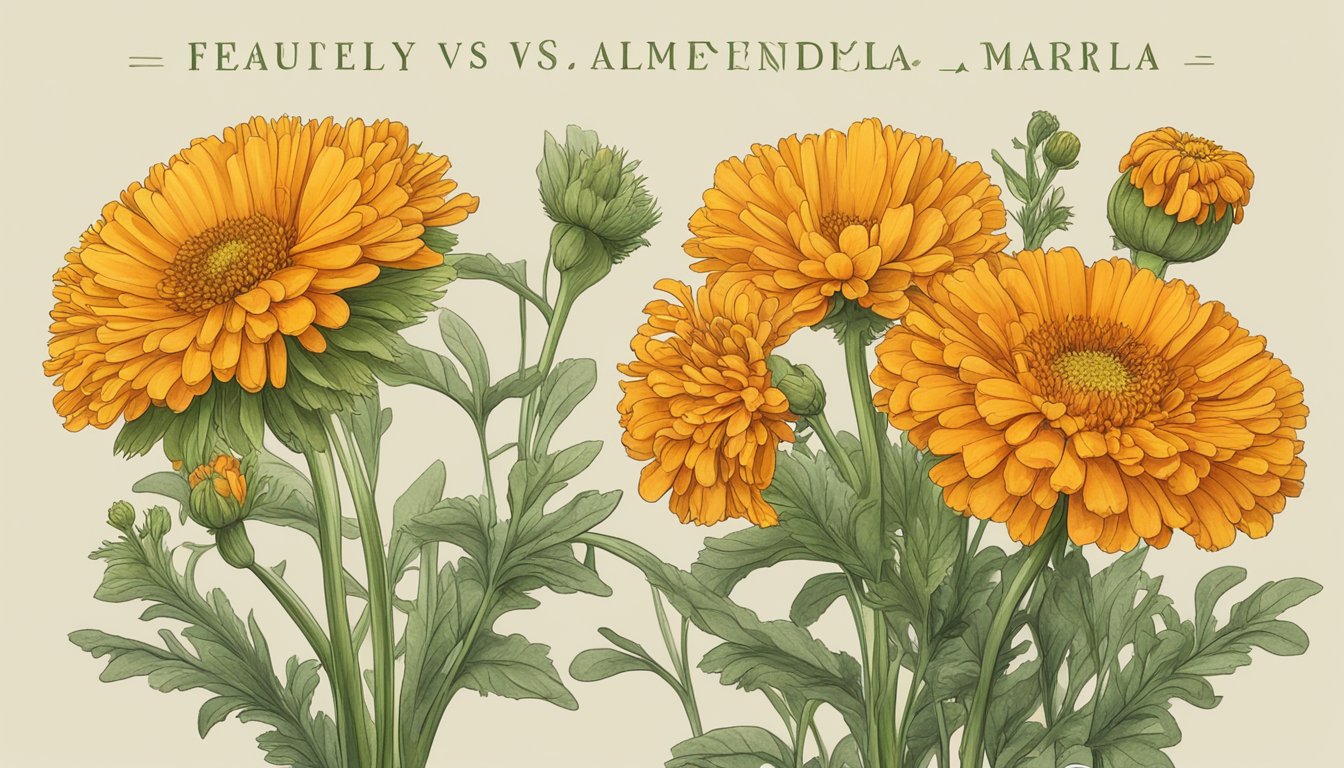TheHerbProf.com is a treasure trove of knowledge for those interested in natural healing and herbal remedies. The website is run by Paul Johnston MD. A naturopathic who has not only received extensive education in the field but also has personal experience in self-healing.
Calendula vs Marigold are two popular plants that are often confused with each other. Both belong to the Asteraceae family and have similar-looking flowers, but they are different in many ways. As someone who has grown both plants in my garden, I can tell you that there are distinct differences between them that are worth exploring.
Calendula, also known as pot marigold or Calendula officinalis, is a medicinal herb that has been used for centuries to treat various ailments. It has bright orange or yellow flowers that bloom in the summer and fall. Marigolds, on the other hand, are annual flowers that belong to the Tagetes genus. They come in a variety of colors, including yellow, orange, and red, and are often used in gardens as borders or to add color to flower beds.
While Calendula and Marigold share some similarities, such as their sun-loving nature and ability to attract beneficial insects, they also have many differences. For example, Calendula is edible and is often used in cooking, while Marigold is not. Additionally, Calendula has a strong aroma, while Marigold has a more subtle scent. Understanding the differences between these two plants can help you choose the right one for your garden or medicinal needs.
Physical Differences Between Calendula vs Marigold
Names
Calendula and Marigold belong to the same family, Asteraceae, commonly known as the daisy family. However, Calendula belongs to the genus Calendula, while Marigold belongs to the genus Tagetes.
There are different types of Marigolds, including French Marigold, Signet Marigold, African Marigold, and Mexican Marigold. Each type has its own unique properties and appearance.
Physical Traits
Calendula and Marigold have physical differences that set them apart. Calendula flowers feature longer petals and rounder, wider leaves. On the other hand, Marigolds have shorter, compact petals and thinner leaves. While both plants are part of the daisy family, Calendulas look more like daisies.
Calendula petals are long and straight, and the blooms are rather flat and bowl-shaped. They may be orange, yellow, pink, or white. Marigold petals are more rectangular with rounded corners. They aren’t flat but slightly wavy. Colors range from orange to yellow, red, mahogany, or cream.
In terms of size, Marigolds are generally larger than Calendulas. Marigolds have a bushy appearance with compact petals and thin leaves, while Calendulas have a more open appearance with wider leaves.
Calendulas have edible flowers, once a staple of English and Dutch cuisine. They also have a distinctive aroma, which is not present in Marigolds.
In summary, Calendula and Marigold have distinct physical differences in their shape, size, color, and aroma. These differences make it easy to distinguish between the two plants.
Growing and Uses of Calendula vs Marigold

Growing Tips
Both calendula and marigolds are warm-season annuals that can be grown in full sun. They are easy to grow and require minimal maintenance. Calendula plants usually grow up to 12-24 inches tall and rarely beyond 24 inches. Marigolds, on the other hand, vary from low-growing, dwarf varieties that do not grow more than 6 inches tall to upright varieties that easily reach 4 feet.
To grow calendula and marigolds, plant the seeds in well-draining soil and water regularly to keep the soil moist. Deadhead the flowers regularly to promote continuous blooming. Both plants are susceptible to powdery mildew, so it’s important to keep the foliage dry. To prevent nematodes, rotate the planting location every year.
Medicinal and Culinary Uses
Calendula and marigolds have medicinal and culinary uses. Calendula has medicinal properties and can be used to treat skin irritations, bruises, and inflammation. It is also used in herbal remedies for digestive issues and menstrual cramps. Calendula petals can be used to make natural dyes for fabrics and yarns.
Marigolds, on the other hand, are not edible and can be toxic if ingested. However, they are used in traditional medicine to treat various ailments such as digestive issues, respiratory problems, and inflammation. Marigold resin is used in the production of perfumes and cosmetics.
Calendula petals are edible and can be used in salads, soups, and stews. They have a slightly bitter taste and add a pop of color to dishes. Marigold petals can also be used to add color to salads and other dishes, but they do not have a pleasant taste.
Both calendula and marigolds can be grown in containers and are a great addition to any garden. They are also used in the cosmetic industry for their skin-healing properties. You can find calendula and marigold plants at your local garden center or online.
Special Features and Companion Planting

Companion Plants for Calendula vs Marigold
Companion planting is the practice of growing different plants together to enhance their growth or to provide mutual benefits. Calendula and marigolds are both great companion plants for a variety of reasons. Calendula is a great companion for vegetables such as tomatoes, cucumbers, and peas, as it attracts pollinators like bees and butterflies, which helps to increase yields. Marigolds, on the other hand, are great for repelling bad bugs and pests, making them a great companion for vegetables like tomatoes, peppers, and eggplants.
Other plants that make great companions for calendula and marigolds include violas, pansies, and other annual flowers. These plants not only add color and beauty to the garden, but they also attract pollinators and beneficial insects like ladybugs, which help to control pest populations.
Unique Characteristics of Each Plant
Calendula and marigolds are both members of the Asteraceae family and share many similarities. However, they also have some unique characteristics that set them apart from each other.
Calendula has long been used for its medicinal properties, and its bright orange and yellow flowers make it a popular ornamental plant as well. It is also known as the October birth month flower and is native to Europe, North Africa, and the Mediterranean. Calendula is a rough and sticky plant that grows well in sizzling summer temperatures.
Marigolds, on the other hand, are native to Mexico and South America and are known for their bright, showy flowers. There are several different species of marigolds, including Tagetes erecta, Tagetes patula, Tagetes tenuifolia, and Tagetes lucida. Mexican marigolds are often used in the Day of the Dead celebrations, while African marigolds are popular for their large, vibrant flowers. Marigolds are also known for their ability to repel pests like snails, rabbits, and deer.
Both calendula and marigolds are great additions to any garden. Whether you are looking to attract pollinators, repel pests, or simply add some color and beauty to your garden, these plants are sure to please.
Before You Go – Calendula vs Marigold

While Calendula and Marigold may look similar, they have distinct differences that set them apart. Calendula has smaller flowers and prefers cooler temperatures, while Marigold has larger, showier flowers and is more heat-tolerant. Both plants have medicinal properties and can be used in cooking, but Calendula is more commonly used for medicinal purposes.
When it comes to gardening, Marigolds are a popular choice for warm-season annuals, blooming first in late spring and continuing on until the first frost of fall. Meanwhile, Calendulas prefer cooler temperatures and will wilt if the weather gets too steamy. If you’re looking to attract pollinators to your garden, both plants are great options.
In terms of similarities, both Calendula and Marigold belong to the same family, the Asteraceae family, and are easy to grow from seed. They also have similar colors, with shades of orange and yellow being the most common.
If you’re looking to add some color to your garden, both Calendula and Marigold are great choices. Calendula is perfect for cooler temperatures and medicinal purposes, while Marigold is great for warm-season annuals and attracting pollinators. With these gardening tips, you can choose the right plant for your needs.
Don’t forget to sign up for our free newsletter to get more gardening tips and tricks!
Calendula vs Marigold: A Symbiotic Dance
Hello, fellow herb enthusiasts! Let’s dive into the world of Calendula and Marigold. These two are like the best of friends in the plant kingdom, each bringing unique benefits to the table. For more exciting herbal insights, don’t forget to check out my homepage.
First off, Calendula. This herb is a powerhouse of healing properties. It’s like the friend who always has a remedy up their sleeve. Got a skin issue? Calendula’s there with its anti-inflammatory properties. Need a health boost? It’s packed with antioxidants!
Now, let’s not forget about Marigold. This vibrant flower isn’t just a pretty face. It’s a natural pest deterrent, protecting its buddy Calendula from harmful bugs. It’s like the friend who always has your back.
When planted together, these two create a dynamic duo. Marigold’s pest deterrent properties keep harmful bugs at bay, allowing Calendula to thrive. In return, Calendula’s strong scent attracts beneficial insects, providing a natural line of defense for Marigold.
So, there you have it! Calendula and Marigold, each helping the other in their unique ways. It’s a beautiful example of nature’s symbiosis, right in our own backyards!
References – Calendula vs Marigold
Little Herb Encyclopedia, by Jack Ritchason; N.D., Woodland Publishing Incorporated, 1995
The Ultimate Healing System, Course Manual, Copyright 1985, Don Lepore
Planetary Herbology, Michael Tierra, C.A., N.D., Lotus Press, 1988
Handbook of Medicinal Herbs, by James A. Duke, Pub. CRP Second Edition 2007
The Complete Medicinal Herbal, by Penelope Ody, Published by Dorling Kindersley
Check the Following Articles!
Chamomile Vs Daisy: A Comparison of Two Popular Flowers
Tulsi Vs Basil: Differences and Similarities
Mugwort Vs Wormwood: A Comparison of Benefits & Uses
Frequently Asked Questions – Calendula vs Marigold

What are the culinary uses of calendula compared to marigolds?
Calendula and marigold are both edible flowers that can be used to add color and flavor to dishes. However, calendula petals have a milder taste than marigold petals, which have a slightly bitter taste. Calendula petals are often used to make tea, while marigold petals are used to add color to soups, stews, and salads.
How do the medicinal benefits of calendula differ from those of marigolds?
Calendula and marigold have been used for centuries for their medicinal properties. Calendula has anti-inflammatory and antiseptic properties and is often used to treat skin conditions such as eczema, psoriasis, and acne. Marigold has antifungal and antibacterial properties and is often used to treat digestive issues such as diarrhea and constipation.
Can calendula petals be used in the same way as dried calendula flowers?
Yes, calendula petals can be used in the same way as dried calendula flowers. They can be dried and used in teas, tinctures, and salves.
What are the differences in growing conditions for calendula seeds versus marigold seeds?
Calendula and marigold are both easy to grow from seed. However, calendula prefers cooler temperatures and can be grown in partial shade, while marigold prefers full sun and warmer temperatures.
Are there any pest control benefits associated with planting calendula or marigolds?
Yes, both calendula and marigold are known for their pest control benefits. They can be planted in vegetable gardens to repel pests such as aphids, whiteflies, and nematodes.
What should be considered when using calendula for its purported health benefits?
While calendula is generally considered safe, it can cause allergic reactions in some people. It is important to talk to a healthcare provider before using calendula for its purported health benefits. Additionally, calendula should not be used as a substitute for medical treatment.


